Le Marche's Famous People
The Birthplace of World-class Talent
The birthplace of and source of creative inspiration for world-class talents throughout the centuries.
From education (Maria Montessori) to sports (Valentino Rossi, motorcycle racer; Valentina Vezzali, fencer); poetry (Giacomo Leopardi); opera (Beniamino Gigli, tenor; Renata Tebaldi, soprano); composition (Gioacchino Rossini; Giovanni Allevi); mathematics (Ostillio Ricci, Galileo’s first teacher of geometry); architect (Donato Bramante); among many others, Le Marche continues to influence the world.
Art & Architecture
Education
Law
Leaders
Performing Arts
Scholar
Scientist
Sports
Poet & Philosopher
Art & Architecture


Adolfo De Carolis - Painter, Xylographer, Illustrator and Photographer
Born: 6th January 1874, Montefiore dell'Aso, Province of Ascoli Piceno, Le Marche
Died: 7th February 1928, Rome
Adolfo de Carolis was born in Montefiore dell’Aso on the 6th January 1874, the son of a local doctor. He studied art at the institute in Bologna, and then he won a bursary to study decorative painting at the Museum of Industrial Art in Rome.
He became a member of the group called ‘In Arte Libertas’ (Freedom though Art) which espoused the PreRaphaelite philosophy, and he particularly admired William Morris, Edward Burne-Jones and Walter Crane. He was a prolific painter (in particular of murals), but also an interior designer, decorator, xylographer (engraving on wood), illustrator and photographer.
Between 1897-1904 he contributed to the decoration of the Villa Brancadoro in San Benedetto del Tronto and the ballroom of the Palazzo della Provincia, both in Ascoli Piceno, the Palazzo del Podestà in Bologna, the Baptismal Font at the Cathedral of Ajaccio, the Villa Blanc, Villa Manzi and the Palazzo Vidoni, as well as undertaking restoration work in the Borgia apartments in the Vatican.
Two of the greatest Italian writers and poets of the day, Gabriele D'Annunzio and Giovanni Pascoli, both greatly appreciated his talent, and he became their preferred illustrator. Among his most popular works were many illustrations for Gabriele d'Annunzio's novels (Il Notturno and La figlia di Jorio) and Giovanni Pascoli‘s volumes of poetry.
De Carolis died in Rome on the 7th of February 1928 before finishing the illustrations for a series of books on the Greek Poets published by Zanichelli.
The Museum in Montefiore dell’Aso displays a total of five hundred works by Adolfo de Carolis.

Self Portrait of Federico Barocci, 1600
Federico Barocci - Renaissance Painter and Printmaker
Born: 1528, Urbino, Province of Pesaro and Urbino, Le Marche
Died: 1612, Urbino, Province of Pesaro and Urbino, Le Marche
In his time Federico Barocci was one of the most celebrated and highest paid artists of his generation and a major influence on key figures such as Rubens, Annibale Carracci and Guido Reni. Among his patrons were Le Marche’s Duke of Urbino, Pope Pius IV and the Emperor Rudolf.
Barocci first apprenticed with his sculptor father, before emerging as a promising artist in the ‘mannerist’ style of the era and joining a studio in Rome in 1548. He returned to Urbino for a time but was summoned back to Rome at Pope Pius IV’s request where he produced several stunning paintings and frescos for the Vatican.
During this time Michelangelo took a keen interest in Barocci’s work and it’s alleged that other young painters were so jealous of his talent and popularity that they poisoned his food at a picnic. Plagued with intestinal issues, Barocci returned to Urbino in 1563 where he remained for the rest of his life.
Ill-health, however, didn’t stop him continuing to produce an oeuvre of extraordinary and unique work. His distinctive style and colour palette of dazzling pinks, oranges and lilacs illuminate his paintings and dynamic altar pieces. He wanted his viewers to be moved by religious rapture when they looked at his work. He also believed colour contained music, once saying as he worked: ‘I am composing a tune.’
Many artists were influence by his paintings, Rubens in particular is known to have sketched Barocci’s ‘Martyrdom of St Vitale,’ (1583). Barocci was an obsessive draughtsman, the first Italian artist to make detailed preparatory drawings with chalk and oil pastels.
When he died in 1612 he left almost 2000 drawings, most of which are preserved in Le Marche. Despite his fame at the time, Barocci’s legacy is less than it should be, possibly due to the overtly religious nature of his work and the fact most of it has been housed in remote Marchigian churches for over 400 years.
Video - Federico Barocci: Drawings / Brilliance and Grace
Video - Federico Barocci: Human and Divine / Brilliance and Grace
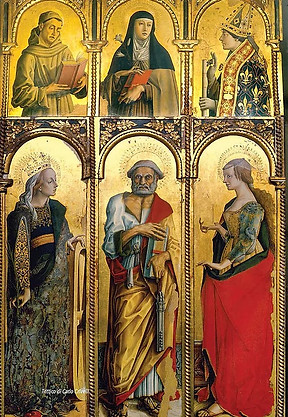
Carlo Crivelli - Renaissance Painter
Born: 1435, Venice
Died: 1495, Ascoli Piceno, Province of Ascoli Piceno, Le Marche
“Carlo Crivelli is one of the most important, but historically neglected, painters of the 15th century. He manipulated the surface of each painting with rare mastery of the medium, crafting visionary encounters with the divine.”
The Museum of San Francesco in Montefiore dell'Aso has a room dedicated to the great 15th century painter Carlo Crivelli, with one of the greatest examples of his works. Many of his other works can be found across the Marche, and many of them in the churches for which they were intended. One of the best examples is the famous triptych which was in the church of San Francesco but is now in the museum.
Crivelli was born in Venice in about 1430. Sadly, little is known of his life, but we know that he studied in Venice and probably Padua. Later he moved to the Marche, in or near Ascoli Piceno,(though the exact location is unknown), until his death around 1493.
The influences of the Venetian school are clear in his work. However, his style developed along different lines. His work is full of strong lines and vibrant colours, and he was particularly fond of using verdant rural landscapes full of flowers and fruit as backgrounds to the religious scenes depicted. His work is entirely religious in subject matter, probably because his commissions all came from wealthy religious orders in Ascoli.
As well as his trademark flowers and fruit, he was also adept at conveying horror. The mouths of many of his subjects are twisted in grimaces of agony, and wounds are gaping and raw, in contrast with the softness of image that was becoming popular in the Florentine school. He is considered as somewhat conservative in his style, favouring the International Gothic style over Florentine developments. It is possibly because of this conservatism that he fell out of favour after his death.
Triptych by Carlo Crivelli (1435 - 1495), Montefiore dell'Aso, Polo Museale
In Vasari’s significant work ‘The Lives of the Most Excellent Painters, Sculptors and Architects’(1550) he is not even mentioned. There was a brief resurgence of his popularity when the Pre-Raphaelite movement, particularly Edward Burne-Jones, espoused him in Britain.
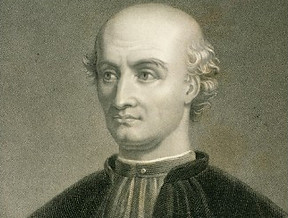
Donato Bramante - Architect and Painter
Born: 1444, Fermignano, Province of Pesaro and Urbino, Le Marche
Died: 11th March 1514, Rome
Bramante is a very significant figure in the history of architecture, with the reputation of having created the architectural style of the High Renaissance. He transformed the classical style of the 15th century into something grave and monumental, and this came to represent the ideal for later architects. He was also a painter, and his first known painting dates from 1477, when he decorated the facade of the Palazzo del Podestà at Bergamo with a frescoed frieze of philosophers. However, his architectural genius very quickly eclipsed his reputation as a painter. The Montefeltro Court in Urbino at that time was a significant cultural centre, and he would have been influenced by artists such as Piero dell Francesca.
Donato Pascuccio d'Antonio was born in 1444 in Fermignano (then known as Castrum Monte Asrualdo). Unfortunately, very little is known of his early life here, and there are no examples of his work in the town. He was adopted as the court architect by Ludovico Sforza in Milan in 1474, where he built the famous ‘trompe l’oeil’ choir of the church of Santa Maria. Other early works include the Cloisters of Sant'Ambrogio (1497–1498). Bramante fled the French occupation of Milan in September 1499, and went to Rome, and there came face to face with Roman antiquities.
The impact of the ancient monuments on his work is evident in the cloisters of S. Maria della Pace in Rome (1500-1504). Its simple gravity and monumentality marks a distinct break with the Lombard style. In the first decade of the 16th century Donato Bramante was the chief architect in Rome which attracted all the leading Italian artists. It is particularly the triumvirate of artists—Michelangelo the sculptor and painter, Raphael the painter, and Bramante the architect— who dominated the High Renaissance period, and whose influence was a beacon to following generations. In 1505 he won a competition for a new design of St Peter’s Basilica in Rome, which Pope Pius II, a close friend to Bramante, decided had to be demolished and completely rebuilt in line with modern architectural developments.
Many illustrious artists of the day were involved in the project, but the overall design was Bramante’s. His hand can be seen most clearly in the enormous courtyard of the Belvedere which connects the Vatican Palaces to the Villa of Innocent VIII.
The tiny, circular Tempietto (1510) of San Pietro in Montorio perhaps represents the pinnacle of his achievement. Despite its small scale, the construction surrounded by slender Doric columns, surmounted by a dome, has all the rigorous proportions and symmetry of Classical structures.
Bramante's last work was probably the Palazzo Caprini. It had a rusticated ground floor with shops and an upper story with coupled Doric half columns. Owned later by Raphael, it became the prototype for numerous palaces by subsequent architects, including Palladio, especially in northern Italy. Bramante died on March 11, 1514, and was buried in Old St. Peter's.
A local example of Bramante’s work can be found at Loreto, at the holy pilgrimage site of the Basilica della Santa Casa, a 45 minute drive from Montefiore dell'Aso. The Basilica contains the house in which the Virgin Mary lived. This house is surrounded by a tall marble screen designed by Bramante.

Adoration of the Magi, 1423
Gentile da Fabriano - Renassance Painter
Born: 1370, Fabriano, Province of Ancona, Le Marche
Died: 1427, Rome
Another culturally ground-breaking son of Le Marche was Gentile de Fabriano. He stands to this day as one of the greatest stars of the early Renaissance in Italy, and his style bridges the gap between Gothic and the new Renaissance idiom which developed in Florence in the early 15th century. The new style introduced a softness and elegance, and a use of rich colour and sensual forms.
He was born in Fabriano around 1370 and little is known of his early life nor his artistic influences apart from the fact that both Allegretto Nuzi and Cecco Ghissi were fellow townsmen and he almost certainly absorbed the International Gothic style which they both espoused.
He must have travelled to Venice in 1406/7 as there are records of an altarpiece and a fresco in the Doges palace that he painted there in 1408, though these no longer exists. We do know that he worked at the Malatesta Court in Brescia from 1414 to 1419, but when his commission finished he accepted a post in Rome.
He travelled with the Pope to Florence, where a fashion for the northern Italian and French style was just sweeping the local aristocracy. Fabriano exemplified this new trend, and he was quickly adopted as the artist of choice.
He completed several major commissions in Florence and in 1425 went to Siena and the following year to Rome, where he remained, completing several commissions though these are also tragically lost. He died in 1427, in the convent adjacent to the church of Saint Maria Novella which he had partially decorated at the time of his death.
He had a major influence on the whole development of fine art in the Renaissance, and his artistic heirs include such stellar figures as Bellini, Pisanello, Giovanni di Paolo and above all Fra Angelico.
Tragically so many of his known works have been destroyed or lost, but his existing works also include several polyptyches which have been divided and now appear in sections in major galleries around the world. There is also part of an altarpiece in the cathedral at Orvieto in Umbria which gives you an idea of his sumptuous later style.
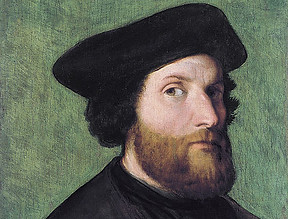
Self portrait by Lorenzo Lotto
Lorenzo Lotto - Renaissance Painter
Born: 1480, Venice
Died: 1556/57, Loreto, Province of Ancona, Le Marche
Although Lorenzo Lotto was born in Venice and is generally considered as representing the Venetian School of Renaissance art, he spent a great deal of his productive life in Le Marche. He was active during the High Renaissance, but his work in unique in marking the transition into 16th century Mannerism.
He was born in Venice around 1480, but he was never as highly regarded in Venice as in other Northern Italian cities because of his individuality of style, even described by some as eccentricity. This placed him outside of, and perhaps ahead of, the Venetian School. After his death in 1556 his fame dwindled, mainly because the majority of his work was created for small, provincial churches. The influence of Bellini is clear from his early works, but we can also identify the influence of Giorgione in the naturalism of his early portraits. His later work shows a move towards the dramatic vibrancy of Correggio.
Several of his paintings can be seen in Le Marche, namely the polyptych for the church of Saint Domenico in Ancona, dating from 1512, which is somewhat reminiscent of Raphael. This can be seen in the Pinacoteca in Recanati. There is also a fresco of St Vincent Ferrer in the church of Saint Domenico. He received other commissions for five altarpieces in Le Marche, but these are unfortunately lost.He moved from town to town in the later part of his life, in search for patrons. He spent much of the time in Jesi, Ancona and Macerata, before returning to Venice, but his fame had long been eclipsed by Titian, so he returned to Le Marche, finally settling in Ancona in 1549.
At the age of 70 he finally lost faith in his ability to earn a living as a painter, and 1552, having always been deeply religious, he joined the Holy Sanctuary at Loreto as a lay brother. During this period he decorated the Basilica of Santa Maria, and painted a Presentation in the Temple for the Palazzo Apostolico in Loreto. When he died in 1556 he was buried, according to his wishes, in the habit of a Dominican brother.He was rediscovered by the Art world at the end of the 19th century, thanks to the work of the art critic, Bernard Berenson, and has now been recognised as a master of the High Renaissance.

Self portrait by Luigi Fontana

Fresco situated in Church of Santa Lucia, Montefiore dell'Aso
Luigi Fontana - Painter, Architect and Sculptor
Born: 19th Feruary 1827, Monte San Pietrangeli, Province of Fermo, Le Marche
Died: 27th December 1908, Monte San Pietrangeli, Province of Fermo, Le Marche
Luigi Fontana can be enjoyed as a beacon to the value of art, in terms of moral and social improvement. These values are expressed in the form of history painting, religious themes, mythology and allegory, with an historical awareness of the need to keep this tradition alive.
He was born in 1827 in Monte San Pietrangeli, the son of a family of architects and builders, who built, among many other fine buildings, the Fontana Palace in his home town. At the age of 17 he went to Fermo to study painting, and his first commission was for some decorations for the Palace of Count Giulicci in 1844.
He then went to Rome and studied with the grand master Tomaso Minardi, with whom he worked for almost twenty years until the master’s death. It was after this time that Fontana became passionate about Neo-Classical concepts and became a stellar figure in the movement.
His Platonic philosophy is evident in all his later work, and he was particularly influential in the growing popularity of the Romanesque Basilica.Some of his most impressive work can be found in Montefiore in the Collegiate Church of Santa Lucia, including large scale works on the life of the Saint, as well as impressive stucco work.
In Montefiore you can also see his faux marble work and stucco reliefs in the church of Santa Lucia in Montefiore. His paintings can be seen in many of the major churches and palaces in Rome as well as in his home town.
Their style is domestic realism, with a real attention to truth, and they convey a simple religious fervour in which undertones of real emotional interactions are clear. One of his most adventurous projects was the construction of a 2 m high solid silver statue of St Philip of Agira, which now stands in the Parish church in Zebbug, Malta. He died in his home town in December 1908.
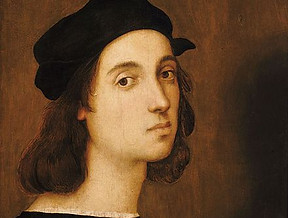
Self Portrait (1504 - 1506)
Raffaello Sanzio (Raphael) - Renaissance Painter and Architect
Born: 28th March 1483, Province of Pesaro and Urbino, Le Marche
Died: 6th April 1520, Rome
Without a doubt, Raphael belongs in the top-tier of Renaissance artists, along with Titian, Donatello, Leonardo da Vinci and Michelangelo. Raphael was at the heart of a group of artists that permanently enriched western culture. His style was considered more refined than that of Michelangelo, having a supremely graceful style. Although he preferred a more classical interpretation of perfection, he was, nevertheless, influenced by the contemporary Florentine school.
Raphael was born Raffael Sanzio in the town of Urbino on April 6 1483. He was the son of Giovanni Santi, a successful painter working at the court in Urbino, which was renowned as one of the centres of innovation and excellence in the visual arts at the time. Raphael would have had the opportunity to learn all the basics of painting during his early years. His mother died when he was just eight years old, and his father when he was only eleven, but fortunately not before securing him an apprenticeship with Perugino in Perugia. He worked as an assistant in his studio until he moved to Florence in 1504.
His career falls naturally into three periods: his early years in Umbria, about four years (from 1504-1508) absorbing the artistic traditions of Florence, followed by his last twelve years in Rome, working for two Popes and their close associates.
In Florence he met Michelangelo and Leonardo da Vinci and was deeply influenced by the new style which they were developing. This influence is visible in the Sistine Madonna. However, although he assimilated the styles of different masters of the time, he continued to pursue his own unique style. This is clear in the painting 'La Belle Jardiniere' from 1507.
In the year 1508, Raphael moved to the Vatican in Rome. His first commissioned work in Rome was his biggest and most lucrative, a fresco for Pope Julius II’s private library in the Vatican palace. This coincided with the painting of the Sistine chapel by Michelangelo. Although this overshadowed Raphael’s work, he was still considered one of the finest painters in Europe.
Some of his greatest works are The School of Athens, The Parnassus and the Disputa. One of his most important papal commissions were the Raphael Cartoons (now in the Victoria and Albert Museum), a series of 10 cartoons (of which seven survive) for tapestries. Raphael is known for his extensive use of preparatory drawings. In addition, he was an ardent user of the metal point technique, which involved using a sharp silver point to make sketches. As well as commissions from the Vatican, he also produced a number of paintings for other clients, including a series of portraits.
When Bramante died, Raphael was named the new architect of St Peter’s. However, most of his work was later demolished as it was considered gloomy. Raphael was also a noted teacher, who had one of the largest workshops in Rome, with over 50 assistants and pupils.
When he died on April 6, 1520 at 37 he was buried in the Pantheon at his own request.
In 19th century England the Pre-Raphaelite Brotherhood explicitly reacted against his influence, seeking to return to styles before what they saw as his damaging influence. They considered his work shallow, and more concerned with superficial perfection rather than inner truth.
Click here to read more about Raffaello Sanzio

Vincenzo Pagani - Painter
Born: 1490, Monterubbiano, Province of Fermo, Le Marche
Died: 1568, Monterubbiano, Province of Fermo, Le Marche
Vincenzo Pagani was born in Monterubbiano around 1490 but unfortunately we know very little of his life. We know he trained in his father’s workshop and probably never worked outside the region. In the early stages of his career he produced paintings in the modern Umbrian style combined with that of the more traditional Carlo Crivelli. An example of this style is Pagani’s altar piece at St Mary’s church in Ortezzano from about 1510.
Vincenzo was introduced to the Venetian masters through contact with Antonio Solario, who was then based in Fermo, and also Lorenzo Lotto, who was working in Recanati. He was deeply influenced by the softer colour palette and the naturalistic background landscapes they employed. His painting after about 1530 reflect this fundamental change, as is witnessed by the Madonna in Glory with Child and Saints, to be found in the Urbani Palace in Urbino.
There are many of his frescos and altarpieces still in situ in Le Marche, for example the wonderful paintings in the Church of Saint Augustin in Ascoli Piceno.
Madonna in Glory with Child and Saints
Urbani Palace, Urbino
Education
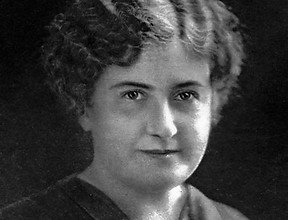
Maria Montessori - Educator, Physician and Innovator
Born: August 31st 1870, Chiaravelle, Province of Macerata, Le Marche
Died: May 6th 1952, Noordwijk, Netherlands
One of the most influential educators of the 19th and 20th centuries, Maria Montessori, was born in Le Marche. She is internationally renowned for her educational theories and there are now 22,000 Montessori schools in virtually every corner of the world. She is perhaps less well-known as a physician, a passionate feminist, philosophical thinker and activist.
She was born in Chiaravalle on 31 August 1870, but the family moved to Rome when she was a child.
She was well-educated and well-read, an unusual thing for a girl at that time, and she demonstrated an insatiable thirst for knowledge from very early in her life. At 13 she enrolled in an all-boys technical institute with the intention of becoming an engineer.
Later she decided on medicine as a career, but she was rejected by the University of Rome. She persevered and eventually was admitted, paving the way for other women in the field. She graduated in 1896 as one of Italy’s first female physicians.
After graduation she practiced psychiatry, but also developed an interest in education. Due to her observations she soon began to question current educational theory, and her own approach began to evolve, initially with regard to the education of children with physical and learning disabilities.
Her first child care centre opened in 1907, La Casa dei Bambini, in Rome, and it proved a great success. The theoretical basis for her method was that children are intrinsically thirsty for knowledge and, given the right environment, will soak up and utilize information of their own volition. Given practical activities which involve the use of Maths or language they will happily learn the necessary skills to complete the tasks if they find them interesting and fun.
Essentially, they teach themselves. Maria designed learning materials and a classroom environment that fostered the children’s natural desire to learn. The extraordinary success of the school became well known throughout Italy and other schools were opened. By 1910 her work was known worldwide.
She travelled very widely during her lifetime and lectured and taught throughout the world. She also wrote a number of articles and books advancing her child-centred education theory, but also her feminist principals. In her day she was a leading figure in the campaign for women’s rights, but unfortunately that part of her professional role has largely been forgotten.
Website: www.fondazionechiaravallemontessori.it
Law

Alberico Gentili - Professor of International Law, Lawyer and Jurist
Born: January 14th 1552, San Ginesio, Province of Macerata, Le Marche
Died: June 19th 1606, London, England
This native son of Macerata is a seminal figure in the history of International Law. He was also the first foreigner to be awarded the title of Regius Professor at the University of Oxford.
Alberico Gentile was born in 1587, the son of Dr Matteo Gentili, a noble and physician in the small town of San Ginesio in the Province of Macerata. He obtained a doctorate in Law at the University of Perugia at the age of 20 and quickly became a major figure in the local community. However he and his father’s interest in, and espousal of, Protestantism meant that they fell foul of the Inquisition and were forced to go into exile. He, his brother and his father fled first to Ljublin, now Slovenia, where Matteo was appointed Senior physician for the Duchy. However, after excommunication by the Pope they were forced to leave this Austrian Catholic region.
Alberico went to England, leaving his brother at University in Germany, and came to London, where he had a letter of introduction to Castiglione, Italian tutor to Elizabeth 1st. Gentili was given permission to teach Law on the basis of his doctorate from Perugia (one of the most highly renowned Universities in Europe) and in 1581 he took up a post at St John’s College, Oxford. He was subsequently offered the title of Regius Professor of Law by the Chancellor of Oxford University, Sir Robert Dudley, 1st Earl of Leicester. This was a prestigious post that he held for 21 years.
As well as being one of the most significant figures in legal education in history, he is also recognized as the ‘father of International Law’. He was the first person to write a treatise on the subject and was also the first person to split secularism from Canon Law and Roman Catholic Theology. His work ‘ On the Laws of War and Peace’ still stands as one of the most comprehensive discourses on the subject. As well as legal treatise, he also wrote extensively on theological and literary topics.
Alongside his academic work, he practiced Law in Britain, particularly for the Admiralty, and he was called to the Bar at Gray’s Inn in 1600. He died in London in 1608 and was buried in Church of St Helen Bishopsgate in the City of London. A monument stands in his home town, San Ginesio, in his honour.
Leaders

Frederic II - Holy Roman Emperor
Born: 26th December 1194, Iesi, Province of Ancona, Le Marche
Died: 13th December 1250, Torremaggiore, Province of Foggia, Region of Apulia
Frederic of Hohenstaufen, red-headed son of Emperor Henry V1 and Constance, Queen of Sicily, was born in Iesi in 1194. He viewed himself as a direct descendent of the ancient Roman Emperors, and was essentially Sicilian in heritage. He was an immensely ambitious man, and his titles during his lifetime included Holy Roman Emperor, King of the Germans (from the age of two), of Italy and Burgundy, King of Jerusalem, and King of Sicily, being crowned at the age of four, as co-ruler with his mother.
He was frequently at war with the Vatican, and the Vatican eventually prevailed, and his dynasty collapsed soon after his death. He was excommunicated four times in his life, and Pope Gregory labelled him ‘antichrist’.
In 1217 he embarked on is first Crusade, historically known as the fifth crusade, but this ended in disaster with defeat at Damietta in 1221. Frederick was blamed for this defeat. When he was called to launch another Crusade he, instead, succeeded in negotiating a treaty in 1229 resulting in the restitution of Jerusalem, Nazareth, Bethlehem and a small coastal strip to the Empire without resorting to aggression. The Crusade ended in a truce and Frederic was crowned King of Jerusalem in 1229.
During his absence from Europe there had been rebellions against him and he had to launch military action to regain lost territory on his return. He lost several of his sons during the battles and became tired and disillusioned. He died, probably of dysentery, dressed as a Cistercian monk in Apulia on 13th December 1250 in Castel Fiorentino. Frederic's will stipulated that all the lands he had taken from the Church were to be returned to it, all the prisoners freed, and the taxes reduced, provided this did not damage the Empire's prestige. The last member of the Hohenstaufen dynasty, Conrad, died in prison in 1272.
His reputation is founded more on his academic, religious and legal achievements than on his military prowess. He was a religious sceptic, and there were suspicions that he carried religious tolerance to an extreme, even to wearing a red robe embroidered with Islamic inscriptions for his coronation. His court in Palermo has been compared to those in Paris or London at this period, in terms of cultural richness and variety.
He developed a collection of Laws, earning him the name of Liber Augustalis, and this remained the basis of Sicilian law until 1819. He was instrumental in promoting Sicilian poetry, and wrote a treatise on Falconry, one of his own personal passions. He also kept a menagerie complete with exotic animals, and he carried out what can only be described as physiological and psychological experiments on humans, including children, with the aim of furthering human knowledge. His knowledge of astronomy was extensive and he was host to many renowned astronomers from around the world. He also founded the University of Naples, which is the world’s oldest state university.

Portrait of the Duke and Duchess of Urbino by Piero della Francesca, 1465 - 1472 (Uffizi, Florence)
Duke Frederico da Montefeltro - Civic leader, Humanist and Military Strategist
Born: 7th June 1422, Castello di Petroia, Region of Umbria
Died: 10th Setember 1482, Ferrara, Province of Emilia-Romagna
Federico, nick named ‘The Light of Italy’, was born on June 7th 1422 in Castello di Petroia, which lies between Perugia and Gubbio. He became a renowned military and political leader in Urbino, He was also respected as a pre-eminent intellectual, gathering around him a large, humanist court in the Ducal palace. He was also one of the contemporary leaders who inspired Niccolo Machiavelli to write the political treatise Il Principe. (The Prince)
Although he was born the illegitimate son of the Duke of Urbino, Count Guidantonio, Pope Martin V legitimised him two years later, against the wishes of his step-mother, who had a child of her own by this time. From the age of 16 he trained as a mercenary soldier under the great ‘Condottiero’ (or mercenary general) Niccolo Piccinino in Perugia.
He was an extremely successful soldier and made a great fortune selling his military services to any local warring leaders who could afford his price. He had been seriously injured in his youth when a lance pierced his helmet visor and blinded him in one eye and destroyed the bridge of his nose. This is why, in the iconic portrait of him in the Uffizi, he is depicted in left profile.
He was also later injured when a floor collapsed and he was subsequently unable to ride or fight due to a serious limp, though he continued to earn fortune and fame as a general and strategist. Although all his wealth was from his mercenary activities, he also had the reputation of being a fair and generous employer, and his soldiers were intensely loyal to him. He was decorated with almost every military honour, and King Edward IV of England made him a Knight of the Most Noble Order of the Garter.
He dedicated himself to developing his court and focusing on art, classical history, science and philosophy. He commissioned the architect Luciano Laurana to design his new palace, and invited artists such as Uccello, Piero della Francesca and the young Raphael to join his court, which rapidly became the capital of Renaissance thought and art.
In 1475 he also commissioned the biggest library in Italy (outside the Vatican) to be constructed in Urbino. It contained more than 760 manuscripts. The small provincial town of Urbino tripled in its territory in a matter of only 40 years due to his military and diplomatic skills.
His second wife was Battista Sforza whom he married in 1460 when she was only 14 years old. She had also received a humanist education and was fluent in Latin and Greek, and it seems that they were intellectual equals, being described by observers as ‘two souls in one body’. She also acted as his Regent during his frequent absences from Urbino. She never recovered from the birth of their seventh child, and died at the tender age of 25. After her death in 1472 Federico went into deep mourning and spent most of his time in the Ducal Place.In 1482, due to the combination of already failing health and a searingly hot summer campaign against the Venetian forces, he died in Ferrara on September 10th.
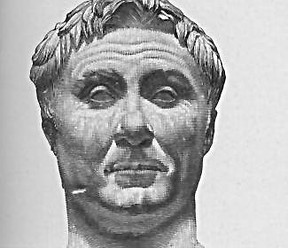
Pompey The Great (Gnaeus Pompeius Magnus) - Roman General
Born: 29th September 106BC, Le Marche
Died: 28th September 48BC, Pelusium, Ptolemaic Egypt
Pompey the Great was a Roman general towards the end of the Roman Empire. He was born in 106 BC from a local family, the Strabo family, in Le Marche, then known as the Piceni region, though we do not know exactly where. The first event for which we have documentary evidence is his involvement in his father’s army in Ascolum (Ascoli) in 89 BCE. He later raised his own army largely made up of veterans from his father’s army in order to fight for Sulla. Sulla was a Consul and General who was attempting to take power over the whole Roman Empire. Pompey was an extremely successful general in spite of his youth, and was much in demand, fighting as far afield as Sicily, Africa and Spain.
He effectively destroyed enemies of Sulla in these regions.He adopted the title of Magnus (great), clearly emulating his hero, Alexander the Great. He also married Sulla’s step daughter, Marcia Tertia, in a move to exert more political influence.
He became a Pro-Consul in 77 BC and claimed credit for defeating the forces of Spartacus, the rebel slave, in Spain. He then became a Consul and was given the task of combating the serious problem of piracy in the Mediterranean. This he did in three months! He was then given command of the entire Roman army.
He, Julius Caesar and Crassus became the three most powerful men in Rome, forming the newly created term, the Triumverate. Pompey divorced his wife Marcia to marry Caesar’s daughter Julia. He became extremely wealthy and funded the construction the Theatre of Pompey just outside Rome, which was opened with extravagant games, and included a temple to Venus complete with a huge statue of Pompey himself.
After Pompey’s wife, Julia, died in childbirth and Crassus was killed in battle, relations between Caesar and Pompey soured and this eventually sparked the civil war. In effect, Caesar’s forces faced those of the much smaller and less experienced forces of Pompey the Great. He suffered an ignominious defeat at Pharsalus, and tried to escape to Egypt, but was brutally murdered without even setting foot on dry land.
Pompey’s career was to some extent typical of a new type of Roman statesman that came to the fore in the late Republic, that of the ‘military dynast’, which could be seen to have had its origins in the careers of Marius and Sulla. However, Pompey tends to be seen by history as one of the great losers, which does not give him credit for his achievements in his earlier career.
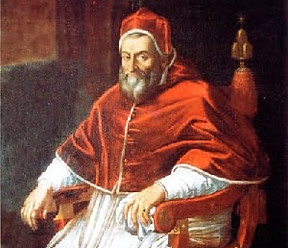
Pope Sixtus V
Born: 13th December 1521, Grottammare, Province of Ascoli Piceno, Le Marche
Died: 27th August 1590, Rome
Pope Sixtus V, born Felice Peretti di Montalto, was perhaps the most notorious of the ten Popes originating from the Le Marche region. He was born in Grottammare on 13th December 1521, the son of a poor family called Peretti, and his father was possibly of Dalmation Slavic origins, and came from the nearby village of Montalto.
It is said that Felice worked as a swineherd in his childhood, but he became one of the most influential and powerful Popes of the Renaissance era. He joined the Minorite convent at Montalto at 8 and became a novice at the age of 12. He rose very quickly through the ranks due to his intellectual acuity and oratorical skills and was initially appointed as rector of the convent in Siena in 1550, quickly followed by other illustrious posts, eventually only six years later, being sent to Venice to serve as a counsellor for the Inquisition.
He was recalled from this post as he was considered too harsh, and instead sent to Toledo in Spain to deal with a charge of heresy against the Archbishop, Bartolomé Carranza. He was a great favourite of the then Pope, Pius V, and chose him as his confessor. He was bishop of Fermo from 1571 to 1577. He then was promoted to Cardinal being known as Cardinal di Montalto. His old rival from Toledo then became Pope Gregory XIII, and Felice retired from public affairs and devoted himself to study and developing his art collection.
In 1585 Felice was elected Pope Sixtus V and burst onto the scene with enormous energy and drive, with revolutionary policies designed to stem the tide of lawlessness which had become rampant in the Papal State. He went about this purge with extreme brutality, but within two years The Papal State had become one of the most secure countries in Europe. He was similarly savage against adulterers and the question of abortion was one of his abiding problems. He also addressed financial issues within the State and succeeded in replenishing the Papal coffers through a number of extreme economic measures. His one major expenditure was on public works, including Palaces, churches and hospices for the poor. He also provided water for the city of Rome and improved the safety and aesthetic quality of the centre of the city, though he had no love of antiquities and utilised many pagan Roman constructions for new Christian purposes.
The way the city appears today is largely thanks to Pope Sixtus V. He also established the Collegio Montalto in Bologna for fifty students from Le Marche. In terms of foreign relations, he aimed to annihilate the Turks and the Egyptians and to put his nephew on the throne of France. He also supported Spain in its attempt to invade Britain by means of the Armada. He renewed the ex-communication of Queen Elizabeth I of Britain, and produced a document lambasting the British monarchy for publication after Spain took control of Britain (which, fortunately, never came to pass!).
Although his reputation has many negative aspects, there is no denying that Pope Sixtus V conceived and implemented some of the most sweeping and dramatic changes in the history both of Rome and of the Catholic church in general.
Poet and Philospher
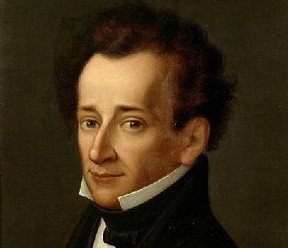
Giacomo Leopardi - Poet and Philosopher
Born: 29th June 1798, Recanati, Province of Macerata, Le Marche
Died: 14th June 1837, Naples
Giacomo Leopardi is probably the most illustrious literary son of Le Marche. He is recognised as one of the greatest thinkers of his period, and, apart from being one of Italy’s greatest poets, he was also a philosopher, a philologist and an essayist.
He was born in 1798 in Recanati, (where the Leopardi Museum regularly welcomes thousands of ‘pilgrims’ each year), and lived there into adulthood. His book of poems ‘Le Ricordanze’ (Recollections) is based on his childhood memories of the place. He travelled widely, but suffered from ill health and regularly returned to the family home in Recanati to convalesce.
His opus magnum was a work published posthumously, the Zibaldone, which roughly translates as a ‘miscellany’, carrying the subtitle ‘Various thoughts on philosophy and literature.’
It consists of personal impressions, philosophical treatise, literary criticism and philological analysis in seven volumes. He died at the tender age of 39, by which time his output was already extensive. An indication of the reverence with which he was regarded is that after his burial in the Church of San Vitale in Naples (where he died), due to public demand, he was re-interred next to Virgil’s tomb in the Parco Virgiliano.
Performing Arts
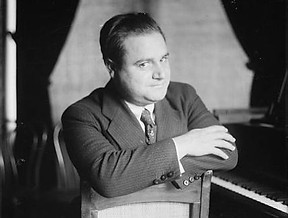
Beniamino Gigli - Opera Singer
Born: 20th March 1890, Recanati, Province of Macerata, Le Marche
Died: 30th November 1957, Rome
Gigli was the most famous tenor of his generation, and is considered by some to be the greatest ever in the recorded history of music. The intrinsic quality of his voice, a honey-toned light lyric tenor, coupled with his sound vocal technique contributed to his success.
He was born in Recanati in Le Marche, the son of an opera-loving shoemaker. He initially was apprenticed to a carpenter, then a tailor, and finally a pharmacist’s assistant while he sang in the local choir and attended school, studying voice and saxophone. When his voice changed he won a scholarship to the Liceo Musical but with the onset of World War I he was drafted into the Italian army. Luckily, as also later happened to the bass Ezio Pinza, a music-loving officer saw to it that he was posted to a non-combat position in Rome.
Gigli auditioned at the Academia di Santa Cecilia and upon graduation won the famous Parma vocal competition. One of the judges wrote: “Finally we have found the tenor.” He made his opera debut in 1914 and after the war ended, made his La Scala debut in 1918 as Faust in a performance conducted by Toscanini. He began his recording career that same year.
His first major success came in 1914 when he won an international singing competition in Parma, and his professional debut was in the same year when he sang the role of Enzo in Ponchielli’s La Gioconda in Rovigo. His major roles came thick and fast in the greatest opera houses all over Italy, culminating with a performance at the metropolitan Opera House in New York in 1920. On the death of the great Caruso in 1921, he took on the mantel of the greatest Italian tenor of the day. There was some controversy over his relationship with the fascist regime, partly due to his having recorded the Mussolini anthem, La Giovinezza, in 1937. He preferred stage performance, but he also acted in over 20 films, including Ave Maria (dir. Johannes Riemann) in 1936, and Pagliacci (dir. Fatigati). He undertook an exhausting farewell world tour in 1955, and his health was seriously impaired by this punishing tour and he died two years later in 1957.

Franco Corelli - Opera Singer
Born: 1921, Ancona, Le Marche
Died: 2003, Milan
Franco Corelli, born in Ancona in 1921, was a leading opera singer on the international stage. He was dubbed ‘The Prince of Tenors’, and had a powerful spinto voice, with electrifying top notes, a clear timbre, and an impressive dramatic presence on stage. He was very good looking and charismatic and became a great favourite of the opera-going audiences throughout Europe and North America.
His parents were not particularly musical, but his grandfather, Augusto, had been an operatic tenor and two of his uncles sang in the chorus at the opera house in Ancona. His elder brother, Aldo, also gave up formal education to become a professional baritone. His father was a shipbuilder, and Corelli followed in his footsteps and studied naval engineering at the University of Bologna. He happened to enter a singing competition while at university, and, although he did not win, the judges encouraged him to transfer to the Pesaro Conservatory of Music and pursue a singing career. He was very largely self-taught as he had been disillusioned with his first singing teacher, Rita Pavoni, and decided that singing teachers were too dangerous and potentially damaging to his voice. His greatest heroes, whose performances he studied in depth, were Caruso and Gigli, amongst others.In 1951 he won the Maggio Musicale Fiorentino in Florence and debuted in Spoleto that autumn. His career took off very quickly from this point, and by 1953 he was on the list of principal tenors at the Rome Opera House. He had a very long and fruitful relationship with Maria Callas, with whom he frequently performed. He featured regularly on programmes at la Scala, Milan, the Arena di Verona, and the Royal Opera House, Covent Garden, amongst other high class European venues.His career as principal tenor at the Metropolitan Opera in New York began in 1961 and continued until 1975. He sang with all the greatest voices of his day, including Leontyne Price, Birgit Nilsson and, of course, Callas.He gave up professional singing in 1975, believing that his voice had lost its brilliance, and he became extremely nervous about performing. Instead he became a popular voice teacher in New York, but eventually died in Milan in 2003, and he is buried in the Cimitero Monumentale in that city.
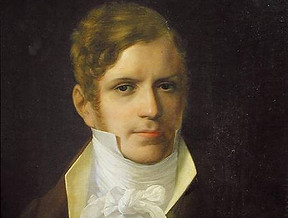
Gaspare Spontini - Composer
Born: 14th November 1774, Maiolati Spontini, Province of Ancona, Le Marche
Died: 24th January 1851, Italy
Gaspare Luigi Pacifico Spontini, composer and conductor, was extremely successful in mid life, and was considered one of the greatest Italian composers of his age. He represented the Napoleonic cultural ideal in music, but he fell out of favour and died disillusioned and depressed in his native Maiolati, now known as Maiolati Spontini.
He was born in the small town of Maiolati in 1774, and, in rebellion with his father’s wishes, abandoned a career in the church and went to Naples to study music. He travelled from city to city in Italy and eventually got his first comic opera premiered in Rome in 1793.
He then moved to Paris and frequented the Imperial Court, having had a successful debut with his opera La Finta Filosofa (The Fake Philosopher) and he was given the title of ‘Compositeur Particulier de la Chambre’. His first successes in Paris were comic operas, but, with the encouragement of the Empress Josephine, he embarked on his first Grand Tragic Opera, ‘La Vestale’. It was a huge success, and paved the way for his new status as a major figure in French Opera. He was awarded the title of Chevalier in Napoleon’s Legion of Honour, and wears the Maltese Cross in his best-known portrait.
After the failure of one of his opera in Paris in 1826, mainly because of political changes in France, he moved to Berlin, where he was Kapellmeister and conductor at the Berlin Hofoper, but after a period of glory he fell into disfavour as Meyerbeer became the fashionable composer of the day.
He then went to England where he was welcomed with great acclaim at Queen Victoria’s court. He briefly returned to Paris, and from there, in 1838, He returned to Italy and lived in Jesi for several years, finally returning to his home town in 1850 where he died only one year later 1851. He is buried in the church of San Giovanni in Maiolati Spontini.

Gioachino Rossini - Composer
Born: 29th February 1792, Pesaro, Province of Pesaro and Urbino, Le Marche
Died: 13th November 1868, Paris, France
Probably the most famous of all the locally born musical celebrities was Gioachino Rossini. Everyone has heard the overture to his opera William Tell and The Barber of Seville; even in his lifetime he was a superstar.
He was born on 29th February 1792 in Pesaro in the Marche, son of a humble parents, though they were also musicians and he grew up in a house full of music.
He lived and worked in Naples, (where he wrote The Barber of Seville and Cinderella), then London and Paris, but, after completing William Tell, he abandoned opera as a medium at the age of just 37, and returned to live in Bologna. After this time he composed very little, and only pieces for his own amusement, such as the beautiful Stabat Mater and a setting of the Mass (Le Petit Messe Solennelle).
He was married twice; first to Isabella Colbran, and then to Olympe Pelissier. She was a beautiful Parisian socialite and artists’ model and held popular cultural salons.
At the age of 63 he returned to Paris where he died on 13th November 1868. His remains were transferred to the Basilica di San Croce in Florence in 1887.
Click here to read more about Gioachino Rossini

Giovanni Allevi - Pianist, Composer and Conductor
Born: 9th April 1949, Ascoli Piceno, Province of Ascoli Piceno, Le Marche
Le Marche has been home to many world-famous composers and musicians, but there is an extraordinary young composer, living and working in Ascoli Piceno, who is currently taking the musical world by storm. Giovanni Allevi, who was spotted during his military service as a promising pianist, went on to gain a diploma in piano from the Conservatoire in Perugia, and then in composition at the G.Verdi Academy of Music in Milan, is currently an internationally renowned pianist, conductor and composer. He also graduated in Philosophy and completed an advanced level course under Carlo Alberto Neri in Arezzo.
After graduation he quickly became the ‘enfant terrible’ of the contemporary classical music world and he is particularly popular with younger audiences with his unique talent and charisma. His musical style rejects atonality and minimalism, while adopting forms from the classical tradition and a new rhythmic and melodic intensity which is fundamentally European.
He has won much acclaim from such august figures as Pope Francis and Pope Benedict, and the President of the Italian Republic. In 2012 he was awarded the Order Of merit of the Italian Republic, and his music has been the subject of many doctoral theses in Italian Universities.
In terms of his public performances, he has undertaken many International tours, and played in the top venues around the world, including Carnegie Hall, New York, the Queen Elizabeth Hall, London, and the Arena in Verona. He has also played in Tokyo, Seoul, Los Angeles and Paris.
He represented Italian music at two Olympic games and has a large catalogue of recordings to his name. He mostly writes for piano, but he is also famed for his solo cello works and a violin concerto. Many of his albums have achieved gold and platinum status, with over 750,000 copies of his albums having been sold to date.
His albums have colourful names, such as ‘Dance of the witch’, ‘Sunrise’, ‘Joy’ and the most recent, ‘Love’. In 2013 he also produced a Christmas album, ‘Christmas for you’ in which he selected traditional, mostly European, Christmas music which he reinterpreted on the piano.
He has also composed the ‘Inno delle Marche’ (The Le Marche Anthem) which was commissioned by a Catholic youth group meeting at Loreto, the Holy Pilgrimage site in Le Marche. Amongst other publications, he published ‘Musica in Testa’ (Music in My Head) In 2008 which consists of anecdotes, observations and stories from his musical career up till then.
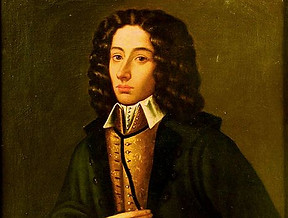
Giovanni Battista Pergolesi - Composer, Violinist and Organist
Born: 4th January 1710, Jesi, Province of Ancona, Le Marche
Died: 16th March 1736, Pozzuoli, Province of Naples, Region of Campania
Pergolesi, the composer, was born Giovanni Battista Draghi in Jesi, but was given the nickname Pergolesi because of his family origins in Pergola in Le Marche. Born in 1710, he studied music in Jesi, and then went to the Conservatorio dei Poveri di Gesù Cristo in Naples in 1725. He spent most of his tragically short life composing for patrons such as Colonna, Prince of Stigliano, and Domenico Marzio Carafa 1V Duke of Maddaloni and Prince of la Guardia.
He had earned a living during his studies by working as a singer and then a violinist and organist for religious establishments and noble salons. During his life time his fame lay in his position as one of the earliest composers of Opera Buffa (comic opera). Even one of his few serious operas contains a two-act intermezzo comic opera, which became famous in its own right. His success in Paris with opera buffa sparked great conflict between exponents of traditional opera and the new Italian genre. This divided the musical community for two years and Pergolesi was held up as a model of the Italian style. His first full opera was first performed in 1731, and all his operas were premiered in Naples apart from L’Olimpiade, which opened in Rome.
Pergolesi wrote some secular instrumental music, including a violin sonata and concerto, but he is probably more famous for his sacred music. Several of his choral pieces have featured in international films, particularly the exquisite Stabat Mater. This was written in the last year of his life when he was suffering from tuberculosis and he died at the tender of age of 26 in the Franciscan monastery at Pozzuoli, leaving an extraordinarily large and original oeuvre.
The main theatre in Jesi, his birthplace, is named after him.
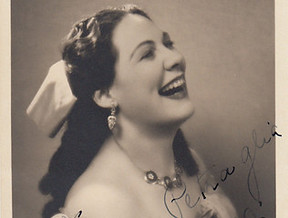
Renata Tebaldi - Soprano
Born: 1st February 1922, Pesaro, Le Marche
Died: 19th December 2004, Republic of San Marino (next to the Region of Le Marche)
The internationally famous lyric soprano was born in Pesaro in 1922. She and Maria Callas were the top two sopranos of their day, and it was said that there was terrible rivalry between them, but this could well have been created by the press. Her voice was very different from Callas’, as she was suited to verismo roles from the lyric and dramatic repertoires. Toscanini said she had ‘the voice of an angel’.
She grew up in Emilia Romagna, just outside Parma. She was struck down by polio when she was just three, which meant that she had very limited activities available to her as a child. She focused almost exclusively on music, and was a talented pianist. She studied piano and voice in Parma and was admitted to the conservatoire there when she was 17. She then returned to Pesaro to study at the Rossini School of Music.
She sang in concert halls and opera houses all over the world, and most notably at the Metropolitan Opera House in New York, where she sang more often than anywhere else in the last years of her professional career. She retired from the stage in 1973 and from her concert career in 1976, and she died at her home in San Marino at the age of 82. She is buried in the Mattaleto cemetary in Langhirano, where she grew up.

Virna Lisi - Actress
Born: 8th November 1936, Ancona, Province of Ancona, Le Marche
Died: 18th December 2014, Rome
The well-known diva Virna Lisi was born in Ancona in 1936. Her father was a marble exporter. They moved to Rome in the early 50s and she was planning at that time to go to business school, but in 1953 a family friend persuaded her to do a film test for the singer Giacomo Rondilelli, and she got the part in his musical. Her future was then decided and she made more than a dozen films in the next two years.
However, she was an intelligent and politically aware woman and espoused left wing views, and her first leading role was in a film directed by the left-wing director, Francesco Maselli, La Donna Del Giorno. She also gave many theatre performances during this time in Rome and in the Piccolo Teatro di Milano.
In the 60’s she decided to try her luck in Hollywood and was snapped up, largely due to her stunning beauty. She managed to bring some depth of character to a string of spineless, glamour girl roles, performing opposite many of the film heroes of the day. She quickly tired of the ‘new Marilyn Monroe’ role which was forced on her in Hollywood, and even refused a lucrative Playboy contract. She returned to Italy and made several more sophisticated films with Italian directors. She also made several films in France, and one British produced film with David Niven. She won the best actress award at Cannes for her portrayal of Catherine de Medici in La Reine Margot, and also won life time awards from the Venice film festival and the David di Donatello prize.
Some of her best-known films were How to Murder your wife with Jack Lemmon, Beyond Good and Evil (about Freidrich Nietsche), and her last Italian film, Latin Lover.
She was a hard-working actress who worked continuously until her death in 2014 at the age of 78, apart from a period in the early 70s when she took time off to bring up her son Corrado.

Matteo Ricci - Churchman and Scholar
Born: 6th October 1552, Province of Macerata, Le Marche
Died: 11th May 1610, Beijing, Ming Empire
Matteo Ricci, born in Macerata on October 6, 1552, went on to become a hugely significant figure in exploration, science, and Europe/Far East relations. He is particularly renowned for his translation of Euclid’s Elements into Chinese, and for translating the Confucian classics into Latin for the first time. He also produced a map of the known world with Chinese characters in order to present the discoveries of European travellers to East Asia. As a boy in Macerata he studied the classics, and then was sent to study Law in Rome, where he entered the Society of Jesus (the Jesuits) in 1571.
He continued to study philosophy and theology, mathematics and astronomy. In 1577 he embarked on a missionary expedition to the Far East, and travelled first from Lisbon to Goa, which was then a Portuguese colony, where he stayed for four years working as a teacher and at the ministry.
He was then summoned to Macau where he prepared to enter China in 1582. He studied the Chinese language, both spoken and written, and Chinese culture and customs. He became the first Western scholar to master Classical Chinese script. He travelled into China with his colleague, Michele Ruggieri, seeking to establish a new permanent Jesuit mission outside Macau.
He was the first European to ever enter the Forbidden City in Beijing in 1601, as the honoured guest of the Emperor Wan Li, with the task of teaching Chinese academics the Western approach to astronomy, the measurement of time and the development of the calendar. He also succeeded in converting a number of Chinese officials to Catholicism, including his colleague and assistant, Xu Guangxi. It was Xu who assisted him in his translations of Euclid and Confucius.
He fell foul of the catholic church because of his tolerant attitude to Chinese religion, Confucianism and cultural norms, and his method was outlawed by the Vatican. Ricci and Ruggieri together produced a Chinese/Portuguese dictionary, the first in any European language, and they devised the first system for phonetic representation of Chinese words using the Latin alphabet. This manuscript was lost for many years in the Vatican archives, and only published in 2001. Ricci travelled and worked widely throughout China, but died in 1610 in Beijing. By a special dispensation he was buried in Beijing in a Buddhist temple built for the purpose. The process of his canonisation is still underway, and he has appeared on the Vatican Congregation for the Causes of Saints ‘pending’ list as a ‘Servant of God (awaiting declaration of heroic virtue)’ since 2014.
Scientist
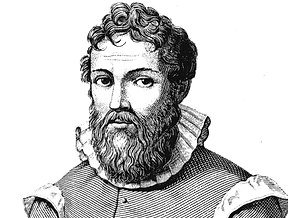
Ostilio Ricci - Mathematician
Born: 1540, Fermo, Province of Fermo, Le Marche
Died: 1603, Florence
Ostilio Ricci was born in Fermo in 1540 of an aristocratic family, and, as far as records show he was never enrolled in a University. Little is known of his early life, but it is known that he studied mathematics under Niccolo Fontana Tartaglia. He became Court Mathematician and taught military engineering for Grand Duke Francesco in Florence in 1580 and he clearly must have given lectures at other institutions because, as a student, Galileo, who was the son of his friend Vincenzo Galilei, attended one of his lectures in Pisa, and was so inspired by it that he changed his course from medicine to Mathematics. Ricci subsequently taught Galileo the fundamentals of Euclid and Archimedes and perspective, all extremely significant in Galileo’s later ground breaking work.
Ricci was a pragmatist and regarded mathematics not as a pure science but as a tool for solving problems in mechanics and engineering. He taught at the Accademia delle Arti del Disegno in Florence, which had been founded by the great Vasari in 1560. He also invented an instrument for surveying land and measuring distant objects, called the Archimetro, which was adopted widely and used by designers and builders. He never published any of his writings during his lifetime, but several are referred to by contemporaries. One, Libro primo delle fortificationi (First book of Fortifications) was discovered in Pisaro and is in the form of lesson notes, presumably for his private students in Florence. Another, dated 1590, is an instruction guide for his Archimetro and was published in 1929 by Federico Vinci under the title ‘L’uso dell’archimetro ovvero del modo di misurare con la vista’.
Sports

Valentina Vezzali - Fencer and Politician
Born: 14th February 1974, Jesi, Province of Ancona, Le Marche
Valentina Vezzali, born in Jesi in Le Marche in 1974, is the first fencer in history to have won three individual Foil gold medals at three consecutive Olympics, Sydney, Athens and Beijing.
She is thought to be one of the best foil fencers in the world, of either gender, and is one of only four athletes in the history of the Olympic games to have won five medals in the same event. And she has two sons with her husband, Domenico Giugliano, and, after the birth of each she was back winning gold medals within four months.
Valentina is also involved in charitable fundraising, being a member of the Gruppo Sportivo Fiamme Oro (The Gold flames sporting club) which is the Sporting wing of the Italian Police force, and a spokesperson for the Italian Multiple Sclerosis Assocaition. She has written two autobiographies and is now a member of the Italian parliament as a representative of the centrist Scelta Civica party, headed by Mario Monti.

Valentino Rossi - Motorcycle Racer
Born: 16th February 1979, Urbino, Province of Urbino and Pesaro, Le Marche
Valentino Rossi, also known as ‘the Doctor’, is a professional motorcycle racer and multiple MotoGP World Champion. He is considered to be the greatest motorcycle racers of all time, with nine Grand Prix World Championships to his name – seven of which are in the premier class.
He was born in Urbino on February 16, 1979, but moved to Tavullia near Pesaro when he was a child. His father, Graziano Rossi, was also motorcycle racer, and he began his son in kart racing. Valentino’s first big success was in the 250cc Grand Prix category which he won in 1999. He went on quickly to the premier class and he won the 500cc world championship in 2001 with the Honda team. Rossi has the most wins in the 500cc/MotoGP category, with 88 victories, and second highest in all categories of motorcycles with 114 race wins, behind Giacomo Agostini with 122.
He has had a long-term feud with the Spanish racer Marc Marquez, but the two finally shook hands at the end of the 2016 Catalan Grand Prix.
He is also famous for his charity work, and he has raised almost a quarter of a million pounds over the past ten years for a charity called Riders for Health, which raises money to fund healthcare in remote villages in Africa. He also raises money for the La Gotita charity, which is an organization that benefits underprivileged children in Bolivia.
Under construction at present (February2017) is the Valentino Rossi Motorcycle Museum outside his boyhood home of Tavullia. Watch this space!












